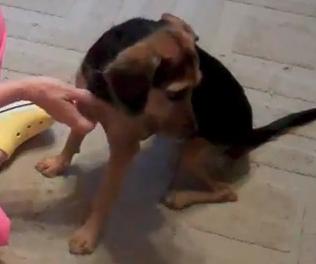 Imagine you are a four-year old child and a complete stranger comes up to you and grabs you and hugs you. You most likely would be terrified and would scream and struggle. Your parents would never let that happen to you. Even if it were someone they knew, if they saw you were frightened they would stop it immediately.
Imagine you are a four-year old child and a complete stranger comes up to you and grabs you and hugs you. You most likely would be terrified and would scream and struggle. Your parents would never let that happen to you. Even if it were someone they knew, if they saw you were frightened they would stop it immediately.
Now imagine the world from your dog’s perspective. You are in the park and a complete stranger comes up to you, bends over you, puts their arms around your neck and squeezes you, and keeps hitting you on the top of your head. You are afraid and have no idea what is happening. You can’t scream like a child but you try to say you are afraid by body language and then by growling. Your human family is oblivious to your signals. Finally you struggle and snap at the scary person to get them away from you. The scary person backs away, but now your human family is yelling at you and jerking you away.
Sometimes it is even unpleasant to be hugged by people we know. I remember as a child being squeezed and suffocated by hugs from my very large, matronly aunts. It was unpleasant but I tolerated it because my parents assured me it was okay. Again, imagine the world from your dog’s perspective. As a dog, if someone familiar hugs you in a way that is uncomfortable or scary, you don’t know it is okay because you don’t understand human language. If you are frightened enough and no one pays attention to your signals telling them you are scared, you just might snap or bite to protect yourself.
Our parents recognized when we were frightened and intervened to remove us from those situations. As dog owners, we have an obligation to recognize when our dog is telling us they want an interaction to stop because it is scary or unpleasant. Dogs say “No” and say, “I don’t like this” through body language signals. If you or someone else is interacting with your dog and he does one or more of the following, odds are he is saying “No!” by the following actions:
• Looks away or moves away
• Puts his ears back
• Shows the whites of his eyes
• Yawns, scratches, or licks his lips
A good way to tell if your dog is enjoying an interaction is to do a consent test. In the consent test, you stop the interaction. If your dog tries to re-initiate the interaction, he or she is saying “Yes.” If your dog simply sits there, looks away, or moves away, he or she is saying, “No.”The consent test is nicely illustrated in a video by eileenanddogs.com:
https://youtu.be/-cGDYI-s-cQ
I believe dogs have a right to say “No” to interactions they find scary or uncomfortable. We humans should recognize when they are saying “No,” and respect it by intervening on their behalf. There was a time when women did not have the right to say no, but most of the world progressed. Perhaps it is time to progress a bit more.
Send your dog training and behavior questions to [email protected].
Or put them in the comments section.









